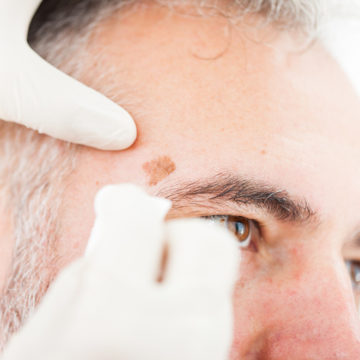
- Besides sun exposure, there are several other risk factors for skin cancer.
- In the U.S, the use of tanning beds and lamps accounts for 400,000 cases of skin cancer each year.
- Skin cancer is genetic.
By now, most of us are aware that too much sun exposure can put us at risk of skin cancer. Susan Y. Chon, MD, associate professor in the department of dermatology at the University of Texas MD Anderson Cancer Center, says intense sun exposure that causes sunburns that form blisters increases a person’s risk of melanoma, the most severe form of skin cancer.
However, there are other risk factors for skin cancer besides sun exposure, such as traits and habits.
1. Light skin, hair, and eyes

People with lighter skin color have less natural protection against UV rays, says Dr. Chon. The same goes for those with blue or green eyes or blonde or red hair. According to the National Council on Skin Cancer Prevention, redheads have the highest risk of melanoma.
People with darker skin are more likely to develop skin cancer on paler areas of their bodies, like the palms of their hands and the soles of their feet, per Dr. Chon.
2. A family history of skin cancer

If you come from a family of light-skinned redheads or tanners, there’s a high chance that one of your relatives has had skin cancer, which also puts you at risk of developing the condition. However, gene mutations linked to pancreatic cancer and breast cancer may also be a genetic risk for melanoma, says Dr. Chon. If someone in your family has any of these risk factors, be more proactive about sun protection. Genetic conditions like xeroderma pigmentosum may also increase your risk of skin cancer.
3. A history of indoor tanning

Tanning beds and lamps expose you to ultraviolet light that tans and burns your skin. Per the American Academy of Dermatology, indoor tanning accounts for some 400,000 skin cancer cases each year among Americans.
4. Old age

Anyone can have skin cancer, but older are at higher risk due to the accumulated UV exposure. According to Dr. Chon, people usually develop non-melanoma skin cancers when they’re in their late 50s. But she says taking measures to decrease sun exposure can delay the onset of skin cancers.
5. Male sex

Men are at higher risk of developing all three of the major skin cancer categories compared to women, namely basal cell skin cancer, squamous cell skin cancer, melanoma, says the National Council on Skin Cancer Prevention.
6. The number of moles you have

Moles that look like freckles are actually sunspots. They are usually not cancerous, but you might have a higher risk of skin cancer if you have too many of them. Try counting the number of moles on your right arm. If you count more than eleven, you likely have more than 100 across your whole body, and you are at a risk factor for melanoma, per a 2015 study.
If you already have too many to count, consider getting regular skin exams with your dermatologist who may do routine skin screenings and take photos of your moles to keep an eye on their changes over time.
7. Weak immune system

When your immune system is down, you are at higher risk of developing skin cancer. According to the American Cancer Society, certain diseases or medical treatments, like post-organ transplant, when patients take meds to prevent their bodies from rejecting the new organ, weaken the immune system.
Via Health
